Brentford have started life as a Premier League club in impressive fashion. They’ve lost just one of their opening seven games and find themselves only four points off the top, but can they sustain this level of performance?
Brentford’s arrival in the Premier League felt both inevitable and impossible, as if the succession of near misses over their recent past might just as easily have caused something to snap and send them tumbling back through the divisions.
I know it probably isn’t the done thing to begin a stats-led article with a discussion of intangibles, but the Bees are built different. From Marcello Trotta’s late missed penalty in their quest to escape League One, through to the decision from David Raya to have a lovely little daydream as Joe Bryan fired home a free-kick in the Championship play-off final in 2020, the London club have been masters of finding new and inventive forms of self-sabotage.
All of this makes it particularly interesting to see them make such a fast start to life in the Premier League now that they’ve finally made it to the promised land. Thomas Frank’s team have taken 12 points from their opening seven league games, with only Leandro Trossard’s late strike for Brighton denying them an unbeaten start.
How sustainable is this start, though? And is there anything in Brentford’s DNA which makes them better equipped to keep going than other promoted sides who have begun top-flight life in a similarly eye-catching manner?
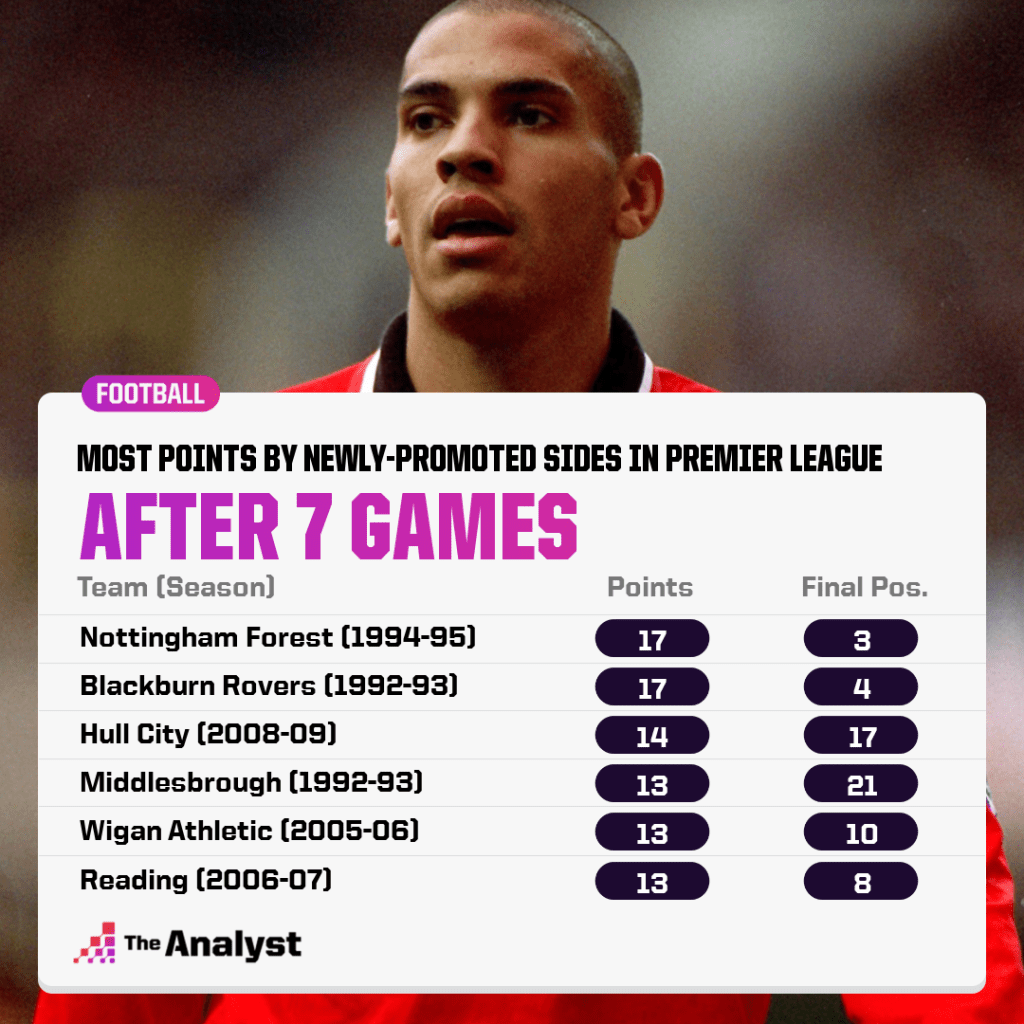
In the history of the Premier League, only six promoted sides have earned more points than Brentford across their first seven games, with four others equalling the Bees’ return of three wins, three draws and a single defeat. However, not a single promoted side in the last decade has picked up more than 12 points at this stage of the campaign (Wolverhampton Wanderers matched the tally in 2018-19).
Were Brentford to continue at this pace, they would finish the campaign on a hefty 65 points – good enough for sixth place in last season’s Premier League, and a tally bettered by only four promoted sides since 1992-93 and none since Ipswich in 2000-01.
These numbers tell us a few things, one of which is that it’s much tougher for teams to gain a foothold post-promotion than it was in the earlier, predominantly more egalitarian top-flight. Indeed, even the newcomers in that era were often among the bigger spenders: Blackburn’s 1992-93 high-flyers were boosted by the arrival of English record-signing Alan Shearer, while Newcastle had the financial muscle to add England international Peter Beardsley the following year, bringing them an extra 21 goals.
A reliable scorer is one thing those top four teams all have in common (or, in Newcastle’s case, two of them). The Magpies had Beardsley and Andrew Cole, Blackburn had Shearer, Stan Collymore helped Nottingham Forest finish third in 1994-95 and Ipswich Town’s fifth place finish in 2000-01 owed a lot to Marcus Stewart’s 19 goals.
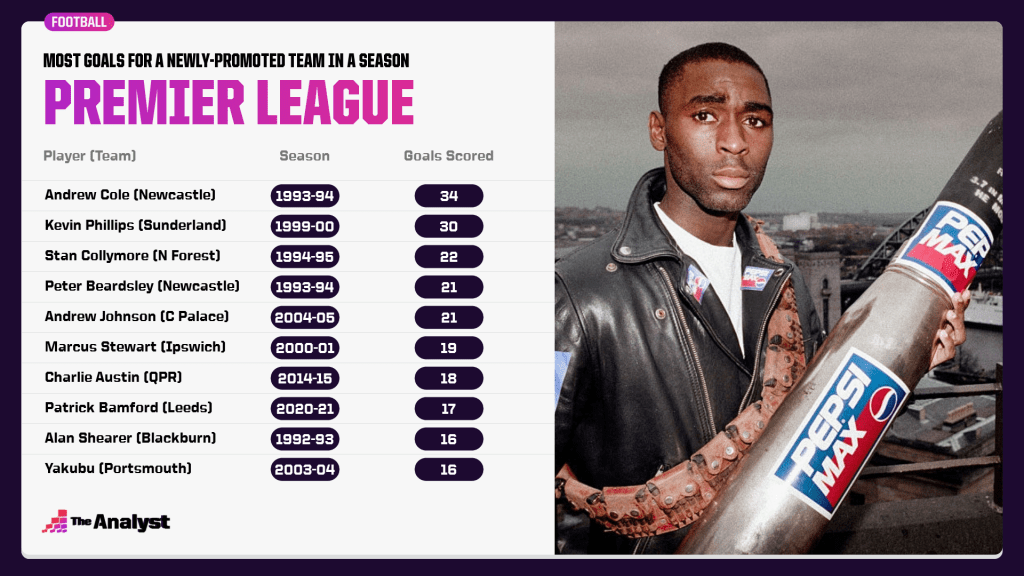
I’ve written here before about the capabilities of Ivan Toney, and the likelihood of last season’s Brentford top scorer repeating his tricks a level up, but the 10 goals scored across the first seven games have come from seven different players and none of those seven have found the net more than twice in the league. It may be worth considering the concept of one prolific goalscorer carrying the team as a relic of the past – of the five promoted sides to hit 10 points by this stage in the last 10 seasons, none have had a player match Stewart’s 19 goals and only two (Leeds last season and Wolves in 2017-18) have had top scorers find the net more than 10 times.
With that in mind, we may need to look at Brentford’s defence as much as its attack to get a feel for what they need to sustain and what needs improvement.
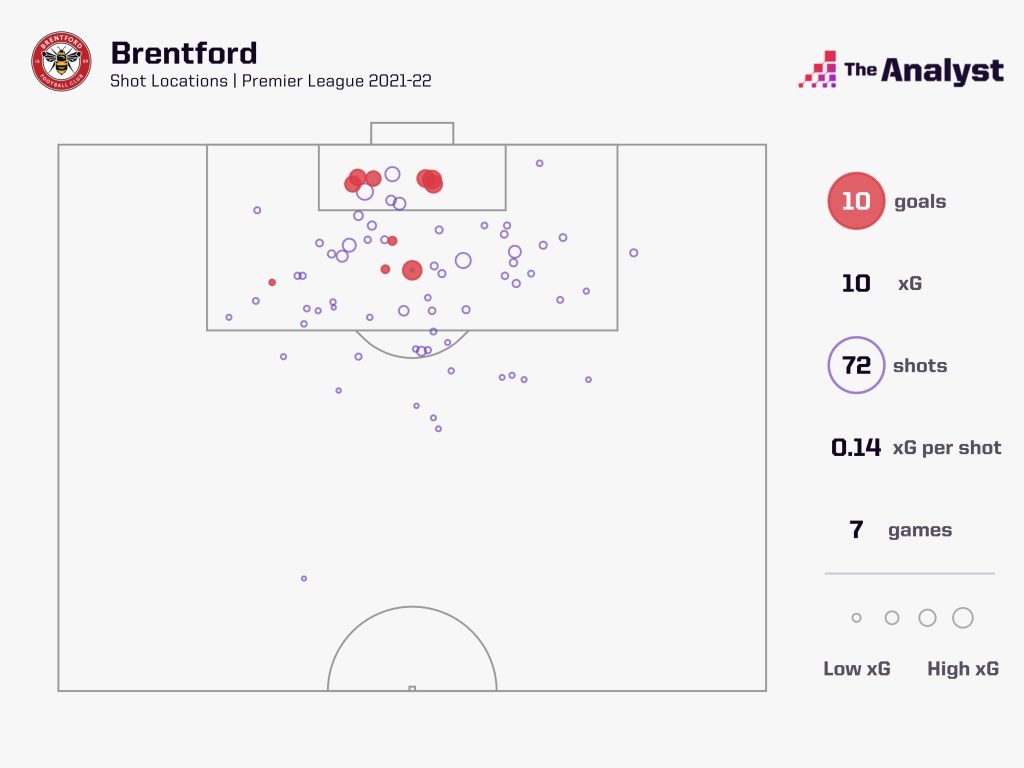
Across the opening seven matches, Brentford are roughly in line with their expected goals scored, while outperforming the numbers in terms of goals conceded. However, even within this context, Frank’s men are doing a decent job of restricting the quality of their opponents’ chances.
This isn’t a case of a team vastly riding its luck in a way which seems destined to come back and bite them, but rather one whose success depends on relative solidity first and foremost. While the goals from Toney last season and Ollie Watkins the year before – as well as supporting efforts from the likes of Bryan Mbeumo and Saïd Benrahma at various stages – might point to an attacking behemoth, it can be easy to overlook the fact that both of Frank’s full seasons in charge saw the club concede less than a goal a game.
Of the four promoted sides over the last five years to secure top-half finishes, three owed a great deal to the strength of defensive solidity in actual terms. However, when we look at the underlying numbers, only Wolves were able to boast a positive expected goal difference. Again, with the caveat that the season is still young, Brentford’s numbers are far closer to those of Nuno’s 2018-19 side than to any of the other sides who calmly went about their business post-promotion: by continuing along this path, there might be less of a requirement to outperform their defensive numbers by a distance (see Rafa Benitez’s Newcastle and Chris Wilder’s Sheffield United) or to continue banging in the goals after the novelty of your arrival in the division has worn off (Marcelo Bielsa’s Leeds, who outperformed their xG but would have still ranked in the top eight had they been bang in line with the numbers).
There might be an argument that the lack of reliance on one single factor like a prolific scorer is an undeniable positive, from the point of view that said scorer can’t be marked, injured or Benteke’d out of form (other strikers to lose their touch overnight exist). The idea of Brentford scoring goals when Toney isn’t doing so can be backed up by, well, seven games of that exact thing taking place. However, when the numbers at both ends are reliant on a collective effort, there’s a greater reliance on (a) keeping up that intensity and (b) being able to identify when one of the myriad moving parts has been jammed in the system and taking it out to prevent a bottleneck. Which brings us onto the final part of this article – squad depth.
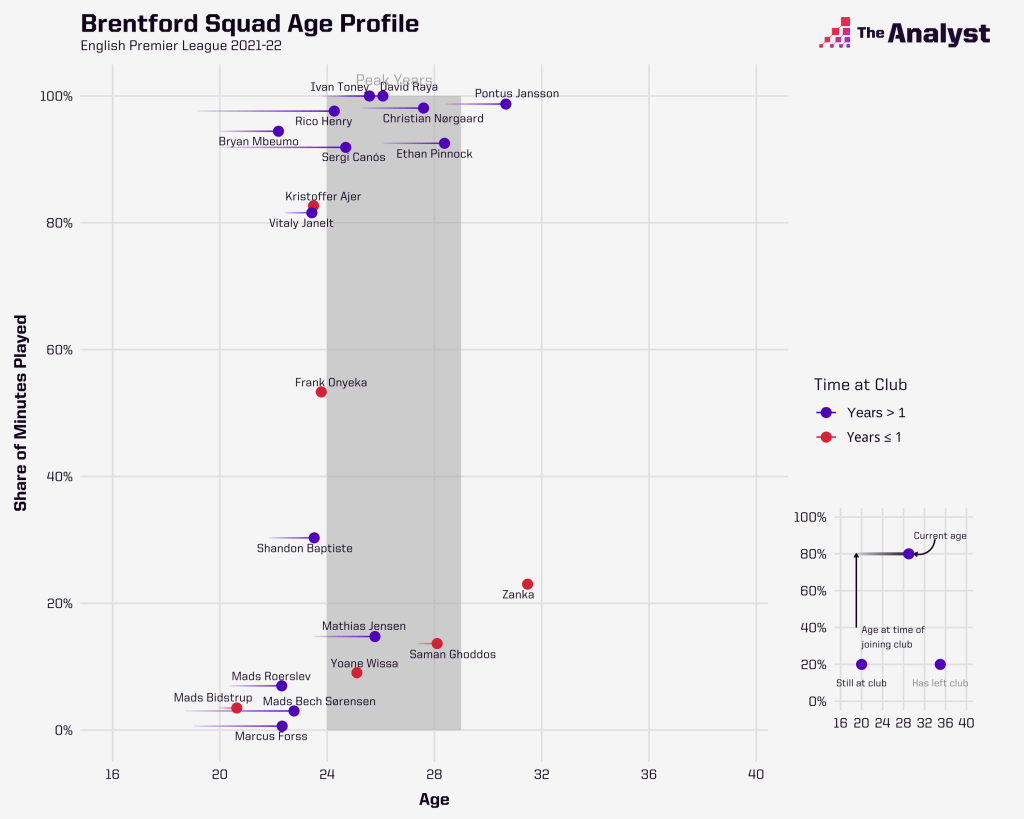
Across the opening seven games of the season, Brentford have already used some 20 players. Some of this has been unavoidable, as with Ethan Pinnock’s injury prompting them to bring Zanka into the starting line-up for the last game and a half, but there has also been a fair deal of rotation further up the pitch. This already demonstrates more variety than Leeds, Sheffield United and Wolves in the aforementioned seasons, and just one fewer than the latter managed in the whole of the 2018-19 campaign.
Sheffield United’s 2019-20 campaign is an interesting point of comparison here: Wilder used 26 players across the season, but only 22 before the turn of the year, at which point a handful of new signings came in and played rarely in the league (Jack Rodwell! Richairo Zivkovic!) Or not at all (they loaned in Panagiotis Retsos? What a wonderful thing to discover two years and 15 FA Cup minutes later). Seven players made more than 30 league starts for the Blades that season, and a further three made 30 or more total appearances in the competition.
This brought about a level of defensive solidity where, yes, opponents were restricted to lower-quality chances than we might expect a promoted side to allow, and especially one which posed as small an attacking threat as Wilder’s side. But it also ensured a level of continuity which, while not a signifier of any statistical guarantees, might have had a psychological impact of ‘well, that’s one less thing to worry about’. Indeed, at the risk of being too results-orientated, Sheffield United’s failure to adapt to the loss of Jack O’Connell to injury in 2020-21 affected them at both ends of the pitch, with chance-creation dropping off as Enda Stevens filled in on occasion at centre-back and the continued attacking bluntness accompanied by an expected goals against figure jumping from 1.34 per game to 1.65.
Brentford have already been forced into some necessary changes at the back across their seven games, while they have already made a significant switch from the side which won promotion by adding Kristoffer Ajer to their defensive ranks.
Here, at both ends of the field, we could see the Bees’ recent adaptability work in their favour: Watkins and Neal Maupay have both needed replacing at the point of their attack, as has Benrahma in a supporting role, and the recruitment under Frank and predecessor Dean Smith has taken place with what looks – from the outside at least – like a clear objective and a holistic approach. While Wolves’ specific approach under Nuno sometimes required new recruits to spend a few months on the fringes before understanding their place, and many of Sheffield United’s recruits were never able to establish themselves in such a way, Brentford appear to have found a way to ensure the transition is less time-consuming. This gives some cause for optimism as we approach the turn of the year, with some faith that new additions might prove reliable, but it also potentially helps ensure few players are overused to the point of burnout before the window opens.
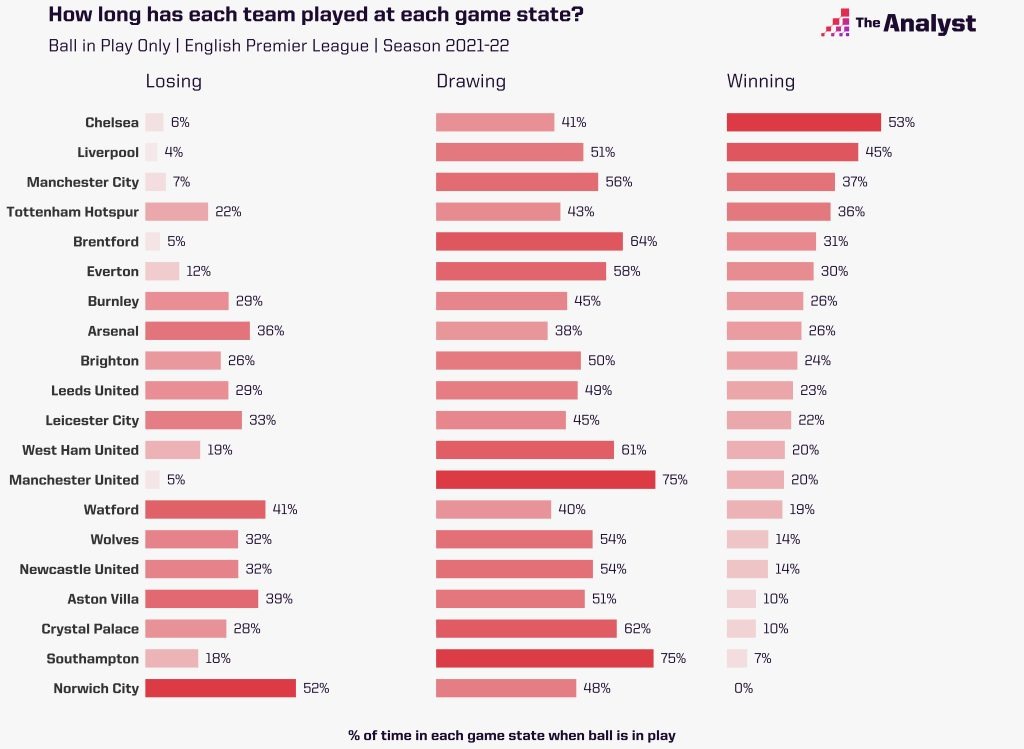
Across the first seven games of the season, Brentford haven’t found themselves handed a particularly easy fixture list, having played two of last season’s top six, four of last season’s top 11, and neither of their fellow promoted sides. Despite this, only Liverpool (4%) have been in a losing position for a lower proportion of ball-in-play time than the Bees in 2021-22 (5%).
They’ve also been forced to deal with an injury to a regular starter in Pinnock, while Josh Dasilva – an important figure across the last two campaigns when fit – is a long-term absentee whose spot has been filled by a selection of different midfielders depending on the opposition and overall circumstances.
All of this is to say things haven’t been going as perfectly as they might have done since August, but at the same time they could yet be faced with bigger inconveniences. The more pressing issue remains that finishing in the top half immediately after promotion is really hard. Since the Premier League began, it’s happened at a rate of less than once per season, with some of the fastest starters this century – West Bromwich Albion in 2008-09 and Blackpool two seasons later – still suffering relegation despite hitting double-figures within their first seven games.
Most promoted sides are starting out life in the Premier League from a lower threshold, given the calibre of player they’re able to attract in the second tier; while there are notable exceptions to this, Brentford are not one of them.
Given all this, a lot of things still need to go right for them to secure a top-half finish. However, they have been doing the right things up to this point, with the numbers and the eye test backing one another up to enough of a degree to convince us this start can be sustained. However, we need to remember it’s a long old season, and the club doing the right things might still not be a guarantee unless they can ensure a few other things don’t go wrong in the process.
Enjoy this? Subscribe to our newsletter to receive exclusive content.
